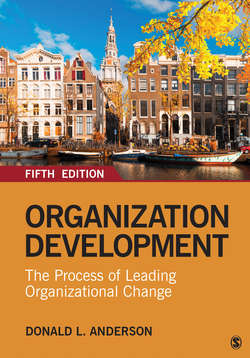Читать книгу Organization Development - Donald L. Anderson - Страница 64
Chapter Four Foundations of Organizational Change
ОглавлениеIn 1996, the St. Louis Post-Dispatch hired a new editor, Cole Campbell, to address declining readership and increased competition. Among the changes instituted in the newsroom was a shift away from reporters being assigned to beats and toward journalistic reporting teams. The staff was generally enthusiastic and optimistic that this change would be a positive one that would increase the paper’s quality, and they welcomed the team-based governance structure. The vision was that teams comprising members from the news and business divisions would collaborate on customer-focus and problem-solving initiatives to improve the paper. As the change was instituted, however, morale declined. Several mid-level editor and reporter positions were eliminated or restructured, and both reporters and editors had to reapply for jobs as team members or leaders in the new structure. Many staff members were frustrated that they were not consulted or involved in making the changes successful. Soon reporters began to dislike working in teams and declared that nothing had actually changed in the quality of the paper. Many award-winning and highly respected journalists left the paper voluntarily, citing the changes in the newsroom. In 2000, Campbell resigned. Circulation had declined from 320,000 to less than 295,000 during his 4-year tenure (Gade & Perry, 2003).
What could have been done differently to make this change successful?
What factors do you think contribute to making a successful change?
As you have no doubt experienced, achieving change is difficult. This story of organizational change at the St. Louis Post-Dispatch has likely been replicated at countless organizations. While it may be tempting to blame the leader and to dismiss failed attempts as yet another example of poorly managed change, it is beneficial to understand what happened in situations like this one and what other explanations are possible. They can teach us about where attempts at change go wrong and how organizational change should be managed differently.
Master the content at edge.sagepub.com/andersonod5e
As we have discussed in previous chapters, organization development (OD) was primarily concerned early on with incremental changes that organizations could experience through interventions that targeted individual development. In recent years, with an emphasis on organizational effectiveness, OD has directed attention toward larger-scale and strategic change. Organizational change is the context (and purpose) of OD work, and a key competency of OD professionals is understanding the nature of organizational change, including what factors help to make changes succeed and what factors cause them to fail. In this chapter we will explore the nature of organizational change, including how researchers and practitioners think about change. We will explore the levels and characteristics of changes that organizations seek to make, and we will look at the research and writings of scholars and practitioners that develop theoretical models for how changes occur, as well as the fundamental issues that make changes successful.
To do that, we will also delve briefly into organizational theory. We will discuss two ways of looking at organizations: as systems and as they are socially constructed. The organization-as-system model has evolved from general systems theory over the past 50 to 60 years. Organizations-as-socially-constructed is a relatively more recent evolution of organizational theory, becoming prominent in the past 20 to 30 years. While these approaches are contradictory in some respects, containing some fundamentally different assumptions at their core, these ways of looking at organizations offer useful and different insights. They suggest approaches to organizational change that can help practitioners as they interpret how to best help a client achieve change in a particular organization. As you learn about these perspectives and models of organizational change in this chapter, keep in mind the practical challenges faced by those who lead organizational change and whether there is one perspective or approach that resonates more with you and your experiences.
You may be wondering why we need to delve into such theoretical detail just to understand how to manage organizational change at a practical level. The answer is that our approach to change depends on the underlying assumptions and beliefs that we have about how organizations work. In other words, “The way change facilitators think about causes of change determines how they contract, assess, intervene, and evaluate during their interactions with client organizations” (Olson & Eoyang, 2001, p. 7). As we have noted in previous chapters, it is important for OD practitioners to be conscious and intentional about the choices they make and to avoid adopting an intervention or model simply because it is fashionable. By learning more about the assumptions behind the models, you will be a more thoughtful and successful practitioner of organizational change.
